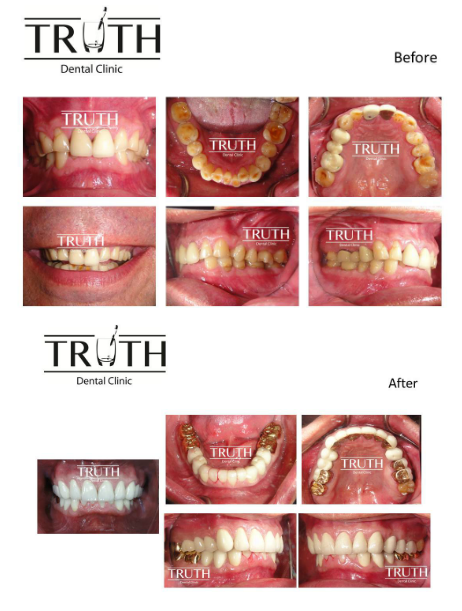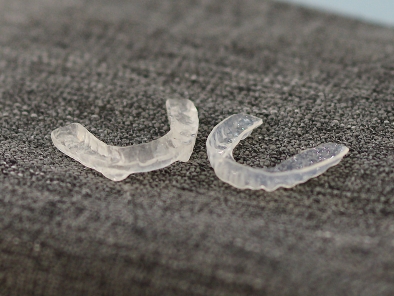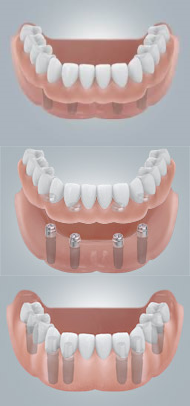Full Mouth Reconstruction
- Introduction
- Mouthguard
- Full mouth implant
Introduction
Full mouth reconstruction or Full mouth rehabitation is a term that describes a treatment to correct your improper bite and enhance the appearance of your teeth and gums. It involves the application of cosmetic and neuromuscular dentistry, which will give patients more functional, comfortable, and beautiful smile.
Criteria :
- Teeth that have been damaged from decay or trauma
- Crack or fractured teeth
- Severely worn out teeth as a result of long-term acid erosion (food, beverages, acid reflux) or tooth grinding
- Ongoing complaints of jaw, muscle and headache pain requiring adjustments to the bite (occlusion)
Types
A. Full mouth or multiple damaged teeth
1) Multiple crowns
2) Multiple root canal treatments
3) Gum treatment
4) Possible Dental substitution: implant, bridge or denture.
B. Full mouth teeth missing
1) Full dentures
2) Full mouth implants
2.1) Implants support removable overdenture
2.2) Implants support hybrid
2.3) Implants suport bridge
Treatment steps:
1) Comprehensive examination and consultation
Upon this appointment, dentist will do oral and x-ray examination to determine the severity of dental problems. A goal of treatment or expectation will be verified at this appointment. Study model and photo taking for further analysis are needed for treatment planing.
2) Treatment planning
At this appointment, you will be informed the extent of your dental problems, treatment options, quotation and timeline. Treatment guide will be developed as a list of procedures for your reference
3) Treatment
Each treatment procedure as outlined in the list of treatment plan will be started in sequence. In case of multiple crowns, a period of provisional crown observation is needed. A prosthodontist will estimate the length of time for this provisional period.
4) Follow up
When all treatment procedures are completed, follow-up period for full mouth reconstruction case is still necessary in order to maintain all restoration or prosthesis durability.

Mouthguard
Occlusal splint
Occlusal splint therapy has been shown to be useful for diagnostic, relaxing, repositioning and reversible device and management of various masticatory system disorders to create neuromuscular harmony in the masticatory system and reduce parafunctional forces.
Type
1)Hard splint :
An appliance that is fabricated from acrylic material to fit the upper or lower teeth. It is removable artificial occlusal surface that fits over the incisal and/or occlusal surfaces of teeth in one arch, creating precise occlusal contact with the teeth of opposite arch
2)Soft splint :
An appliance fabricated from 2 - 4 mm polyvinyl sheet material and usually adapted to the upper teeth. It is quick to fabricate and can be provided as emergency treatment for a patient who presents with an acute TMD. These appliances are generally worn only at night.
Pros
- To protect oral tissues in patients with oral parafunction ( bruxism, clenching)
- To stabilize unstable occlusion
- To promote jaw muscle relaxation in patients with stress related pain symptoms like tension headache and neck pain of muscular origin
- To eliminate the effects of occlusal interferences
- To test the effect of changes in occlusion on the TMJ and jaw muscle function before extensive restorative treatment
- non-harmful way to make reversible changes in the occlusion
Cons
- Wearing an occlusal splint can cause discomfort usually happens during the first few days a patient starts wearing the splint
- Wearing an oclusal splint can cause an increase in saliva, which should disappear over time.

Full mouth implant
Options:
Traditional dentures sit on the top of the gums, don’t prevent bone deterioration, can cause gum irritation, and leave a space that leads to complications. In contrast, implant supported dentures are attached to dental implants with either metal bars or a ball and socket mechanism. They can be removed for regular cleaning or remain fixed, and will function just like your real teeth.
Benefits:
- can be removed for cleaning
- More retentive denture
- Increased ability to eat and speak
- Compensate soft tissue contour
Weaknesses:
- Slight denture movement
- Large and wide extension and soft tissue coverage
- Possible tenderness and soreness from denture compression
- Fair chewing ability comparing to fixed implant prosthesis.
- Periodic denture adjustment
2) Implant supported hybrid prosthesis.
This treatment option is suitable for patients who have posterior bone loss. The procedure maximizes the use of available bone while avoiding the sinus cavity. It is possible to get new functioning teeth the same day as the implant procedure by immediate loading. The final teeth on implant hybrid prosthesis are fixed and there is less tissue or gum coverage than with overdenture.
Benefits:
- Increased stability due to fixed prosthesis
- Less soft tissue extension and coverage compared to the first option
- Possible in severe bone loss cases
Weaknesses:
- Screw loosening possibility requires regular proper maintenance and follow up
- Cleanliness difficulty
- Junction between prosthesis and soft tissue
Type:
2.1) All acrylic bridge option.
2.2) Standard option: casting metal framework with acrylic teeth.
2.3) Titanium framework and composite or porcelain teeth.
3) Implant supported bridge.For this option, multiple implants are placed across the jawbone to provide support for a dental bridge composed of porcelain prosthetic teeth. When replacing teeth in an entire arch, or both arches, of the jaw, the dental implants act as new tooth roots with a fixed dental bridge over these dental implants. With this dental implant tooth option, it is similar for the patient as having a new set of teeth, only this time on implant posts.
Benefits:
- Feels the most like natural teeth
- Most comfortable prosthesis compared with other full mouth implant prosthesis
- Best speech
- Supreme cosmetic appearance
- Chewing like with natural teeth
- Cleanliness like natural teeth
Weaknesses:
- Requires precise implant position on each tooth position
- Requires adequate bone support
- Prosthesis repairing difficulty
- Expensive price








